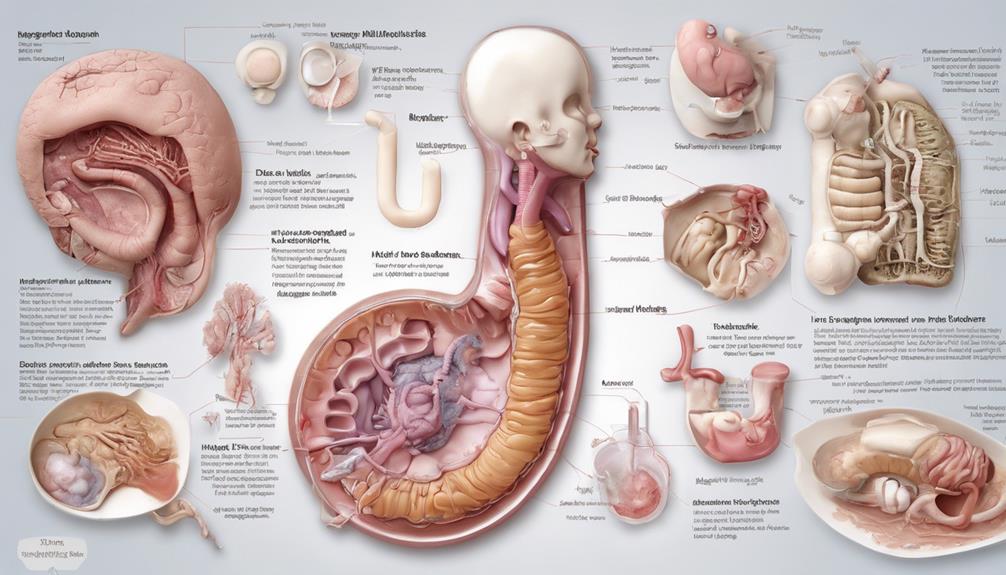As new parents, we often marvel at the mysteries of our little one's first solid poop, akin to cracking a secret code that offers clues to their well-being.
But beyond the initial curiosity lies a vital information that can guide us in understanding our baby's health. From deciphering colors to textures, a baby's poop can reveal much about their internal workings.
So, are you prepared to decode the language of your newborn's first solid poop and guarantee their best health?
Key Takeaways
- Meconium marks the initial phase of bowel movements in newborns.
- Passing meconium is a positive sign of bowel function.
- Transitional stools follow meconium before the first solid poop milestone.
- Monitoring poop frequency helps ensure the baby's health.
Understanding Newborn Poop Characteristics
When we discuss understanding newborn poop characteristics, it's important to recognize the distinct features of meconium, their first solid stool. Meconium is a dark greenish-black substance that's odorless and sticky in texture. This unique appearance is a result of the substances ingested in utero, such as amniotic fluid, mucus, and shed intestinal cells. It plays an important role in the newborn's digestive process, marking the initial phase of their bowel movements.
Within the first few days of life, newborns typically pass meconium before moving to a lighter and less sticky stool. This change signifies the baby's digestive system adjusting to new feedings and functioning more efficiently. By understanding the characteristics of meconium, parents can differentiate it from regular baby poop and monitor their baby's digestive health effectively.
Embracing the appearance of meconium as a natural part of the newborn experience can help alleviate any concerns parents may have about their baby's bowel movements in the early days. Trusting the digestive process and being informed about these initial characteristics can provide reassurance and confidence during this important stage of caring for a newborn.
Frequency of Newborn Poop

Upon observing the frequency of your newborn's poop, you can gain valuable insights into their digestive health and overall well-being. Understanding what's normal for your baby can provide reassurance and help you identify any potential issues early on.
Here are some key points to keep in mind regarding newborn poop frequency:
- Variability: It's normal for newborns to have varying poop frequencies. Some babies may poop after every feeding, while others might go a day or two without pooping.
- Meconium Passage: Passing meconium, the first solid poop, is a positive sign that your baby's digestive system is functioning as it should.
- Transitional Stools: After meconium, your baby may have transitional stools that are a mix of meconium and milk stools.
- Milestone: The first solid poop marks an important milestone in your baby's development, showing that their digestive system is maturing.
- Monitoring: Keeping track of your baby's poop frequency and consistency can help you ensure they're healthy and thriving.
Normal Appearance of Newborn Poop
The normal appearance of newborn poop, also known as meconium, is dark greenish-black, sticky, and odorless. This type of poop is a natural occurrence in babies and is typically passed within the first few days after birth. Meconium consists of amniotic fluid, mucus, skin cells, and other substances ingested in the womb.
As babies shift to digesting breast milk or formula, the color, texture, and frequency of their poop will change. It's important to remember that variations in newborn poop are normal as their digestive system matures. Understanding the typical appearance of meconium can help parents feel more at ease during this stage of caring for their newborn.
If you notice any significant deviations from what's considered normal, it's always best to consult with a healthcare provider for guidance and reassurance. Your baby's poop may change, but being informed about what to expect can help you navigate this aspect of caring for your little one confidently.
Signs of Concern in Newborn Poop

If you notice any concerning changes in your newborn's poop, promptly seek advice from a healthcare provider for proper evaluation and guidance.
When it comes to your baby's first solid poop, there are some signs of concern to watch out for:
- Blood in the Stool: Any presence of blood in your baby's first solid poop may indicate an underlying issue that requires medical attention.
- Unusual Colors: Colors like white, gray, or red in the first solid poop should be discussed with a healthcare provider to ascertain any concerns.
- Mucus in Poop: Persistent mucus in the first solid poop could signal an infection or allergy that needs to be addressed by a doctor.
- Dry Consistency: If the first solid poop appears hard or dry, it could be a sign of constipation, which may necessitate intervention to ensure your baby's comfort.
- Sudden Changes: Any sudden changes in the appearance or texture of the first solid poop should be shared with a healthcare provider for proper assessment and guidance.
Being vigilant and seeking medical attention when needed guarantees the best care for your little one.
Caring for Baby's Bottom
When changing your baby's diaper, always use gentle wipes or a warm, damp cloth to clean their bottom and prevent irritation. For breastfed babies, their poop can sometimes lead to diaper rash due to its acidic nature, making it important to keep their bottoms clean and dry.
After gently wiping, apply a thin layer of diaper cream to protect their skin from moisture and friction. To aid in healing and prevent diaper rash, allow your baby's bottom to air dry for a few moments before putting on a fresh diaper.
Remember to change your baby's diaper frequently, ideally every 2-3 hours, to maintain a clean and dry environment. If possible, consider using eco-friendly diapering products to not only reduce environmental impact but also provide better moisture protection for your little one's sensitive skin.
Frequently Asked Questions
How Solid Should Baby Poop Be After Starting Solids?
After starting solids, baby poop should be thicker and more formed. It's normal for it to change in consistency and color. If it becomes hard or pellet-like, it might signal constipation, necessitating dietary adjustments.
Is It Okay for Newborns to Have Solid Poop?
It's normal for newborns to have solid poop as their digestive systems mature. Changes in color and consistency are expected. If concerned, consult a healthcare provider. Monitoring poop patterns is essential for your baby's health.
What Is a Normal Newborn's First Poop?
We remember that a newborn's first poop, meconium, is dark greenish-black, sticky, and odorless. It's a reassuring sign of a healthy digestive system. Passing meconium within 24-48 hours after birth is normal.
What Does Unhealthy Newborn Poop Look Like?
Unhealthy newborn poop can vary in appearance, indicating issues like constipation, diarrhea, infections, or allergies. Colors like white, gray, or red, mucus, or sudden changes in consistency warrant attention. If concerned, reaching out to a pediatrician is important.
Conclusion
As new parents, we've learned that when it comes to our little one's poop, there's a lot to think about. From frequency and consistency, color and mucus, it's crucial to keep an eye out for any changes.
Remember, a healthy bottom means a happy baby, so don't hesitate to reach out to your pediatrician if something doesn't seem quite right.
Keep up the good work, and happy diapering!









